For these Tribes, the Return of the Bighorn Brings Back a Way of Life
The Confederated Tribes of the Colville Reservation align the principles of conservation with tradition
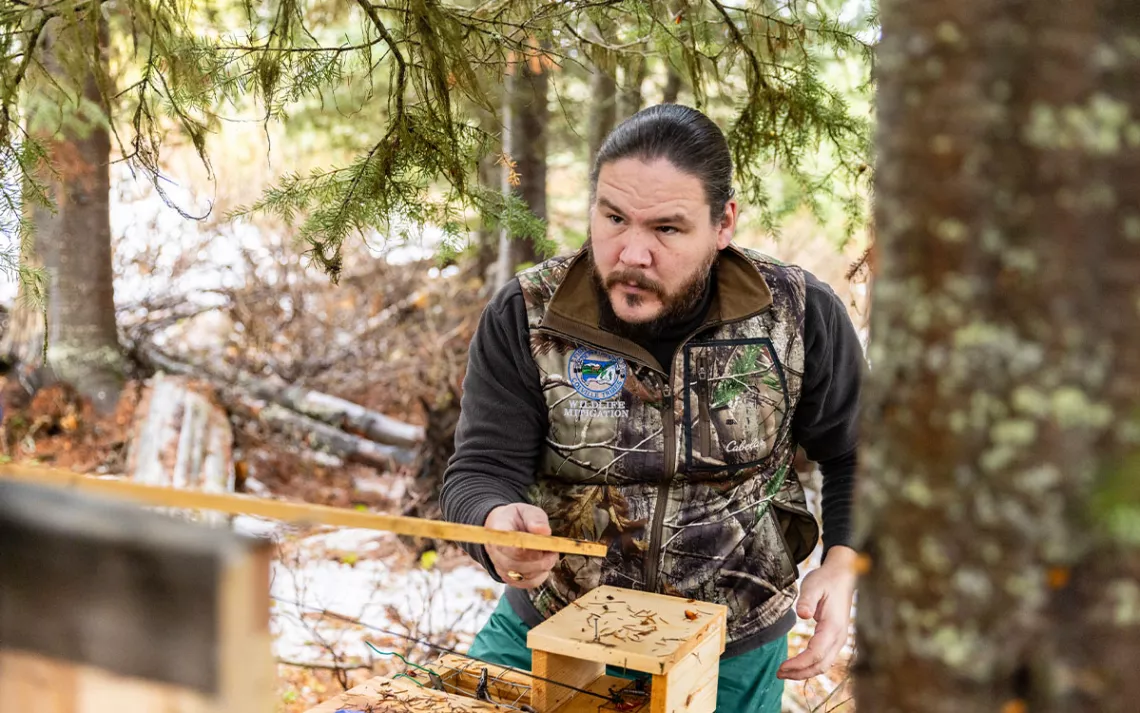
Wildlife manager and tribal member Richard Whitney sets a live trap for lynx in the Canadian Okanagan.
This story is the first in a three-part series that YES! produced in partnership with bioGraphic, an editorially independent magazine about nature and conservation powered by the California Academy of Sciences. Read part 2 here and part 3 here.
From our vantage point in a motorboat on the reservoir known as Franklin D. Roosevelt Lake in eastern Washington, we scan the rocky canyon walls of the Colville Confederated Tribes’ Hellgate game reserve for bighorn sheep. Before it was a reservoir, manufactured by the US government’s Grand Coulee Dam, this was once a mighty, salmon-rich stretch of the Columbia River that formed the basis of an entire ecosystem—and that supported the 12 tribes of the Colville Confederated Tribes since time immemorial.
The boat belongs to Rose Piccinini, the Tribes’ Sanpoil district wildlife biologist. She is part of a team that manages the herd of bighorn sheep that the Tribes’ wildlife department reintroduced beginning in 2009. She also leads the Tribes’ efforts to restore lynx populations back into the ecosystem here.
The animals who shared this landscape were once fully integrated into every aspect of tribal members’ lives. They harvested bighorn sheep and other game for food, tools, and clothing. Intricate myths, legends, and teachings about the animals were passed down by elders to descendants and bound them to who they were—and who, as a result, their descendants came to be.
But then American settlers brought domesticated European sheep and goats, and with them, diseases that bighorns weren’t able to recover from. The succession of disease exposures, against which bighorns had no defense, significantly reduced their numbers and made them more vulnerable to other impacts they might have otherwise withstood. Save for a few small pockets in secluded locations, the bighorns died off, and the herds disappeared from the landscape and the lives of the tribes.

Tribal wildlife biologist Rose Piccinini counting bighorn sheep from the Hellgate herd along the Columbia River on the Colville Tribes reservation. These animals were restored to the reservation by the tribes.
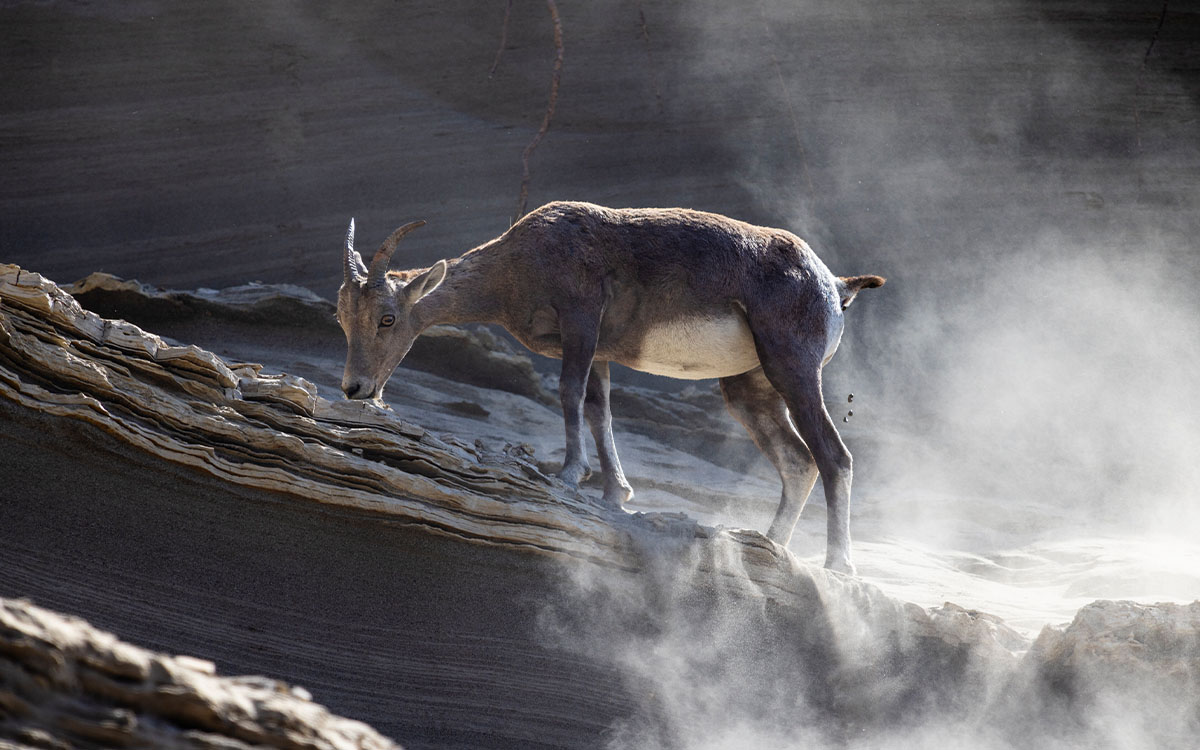
Bighorn sheep from the Hellgate herd along the Columbia River on the Colville Tribes reservation.
As we crane our necks and squint our eyes upward in the hot midday July sun, shadows reveal more than a dozen bighorn sheep on the north side of the canyon, less than 100 feet above the reservoir. Ewes and lambs weave paths through stalks of mullein, leaving their crescent-shaped tracks in the sand, all the while feeding on shrubs that dot the hillside and scree. Their sharp horns curl back from their heads as their amber eyes attend to their surroundings. Two of the animals walk onto a sandy section of the slope, licking at minerals. They kick up dust and cascades of sand, which form rivulets and accumulate into plumes, slowly fanning down the sandy slope to the shoreline below.
For the 12 tribes of the Confederated Tribes of the Colville, whose reservation is located in north-central Washington State, their ecosystem isn’t complete without the animals and plants who have long inhabited the land alongside them. Maintaining these relationships of reciprocity in modern times involves the protection and reintroduction of native species, as well as the restoration of their habitats, an ambitious effort that the Tribes’ wildlife department has been leading since its inception in the 1970s.
As the Tribes work together to restore more native species like bighorn sheep and salmon to their lands and waters, they bring collective healing with them. This healing is felt by the people who have long endured cultural trauma from the forces of European and American colonization. It further strengthens their enduring resilience.
Bighorns were among the Tribes’ first relatives to be extirpated from the region, but the world-shattering impacts of colonization only intensified henceforth.
Salmon have always been at the center of the Tribes’ culture and, until the mid-20th century, their diet and economy. The fish fed the people and the land with, among other things, the nutrients stored in their bodies. The fish consumed sea life and later carried this sustenance upstream in their migratory journey inland. Tribal representatives cite reports of 20,000 salmon per day, weighing on average 35 pounds each, swimming up the Columbia. With their death and decomposition, the nutrients brought by the salmon in their flesh and bones nourished the forests, prairies, and riparian areas, as well as the coyotes, deer, elk, bighorn sheep, lynx, pronghorn, buffalo, wolves, eagles, and innumerable other beings interconnected within these systems.
But in 1942, the US government built the Grand Coulee Dam and “ended a way of life,” according to a documentary produced by the Tribes. The dam blocked 1,400 miles of salmon spawning habitat and flooded 56,000 acres of land as well as the ecosystems that supported whole communities of animals and people. This included critical winter habitat for deer and elk and areas the Tribes relied on for native food and medicinal plants, all of which were drowned by the government’s dam construction.
No fish passage was built then, nor since.

The dense subalpine forests of the Kettle Range and other mountains on the Colville Tribes' reservation and the lands they comanage to the north of the current reservation boundary (referred to by the tribes as “the north half”) are excellent habitat for Canada lynx and their primary prey, snowshoe hares.

The Grand Coulee Dam on the Columbia River, finished in 1942 by the US government, destroyed all anadromous salmon runs above. The dam is a mile wide and 550 feet tall, and backs up the river for more than 150 miles. The river marks the boundary of the Colville Reservation (which lies to the north, in the lower section of photo).
“Overnight, it was shut off,” says Richard Whitney, a member of the Sinixt band of the Colville Confederated Tribes and the Tribes’ wildlife department manager, who assumed leadership of the department in 2014. All at once, salmon, who were the Tribes’ staple food and the foundation of their culture and economy, were gone.
To survive, the Tribes turned to other species native to the ecosystem and started a decades-long effort to restore wildlife populations in the area. By 1975, the Tribes had established a wildlife management department with funding from the Bureau of Indian Affairs, in accordance with the bureau’s trust responsibilities to the Indigenous peoples with whom it had signed treaties. Elk, Whitney says, have, “stepped up to offer themselves so [the Tribes] could persist.”
Today, thanks to the Tribes’ reintroduction efforts, their elk herds are strong, going from 481 total elk counted in 2002 to more than double that in 2022. Whitney says elk numbers on the reservation are at a 20-year high, which gives tribal members additional opportunity for harvest.
With elk reintroduction efforts underway, the Tribes next turned their attention to sharp-tailed grouse in the late 1990s, bighorn sheep in 2005, pronghorns in 2014, followed by lynx, salmon, and buffalo.
Although they have not reintroduced wolves, the Tribes have allowed wolves to recolonize their lands, since evidence of the canines was first identified in 2008. Wolf packs are now managed here at a stable level.
The Colville Confederated Tribes’ plan to re-establish bighorn sheep began with six translocations that ultimately brought 136 bighorns back to the reservation. Although the herds have continued to suffer from diseases carried by domesticated goats and sheep—which are worsened by drought as it concentrates animals around smaller watering areas—Whitney says the population has since grown to more than 250.
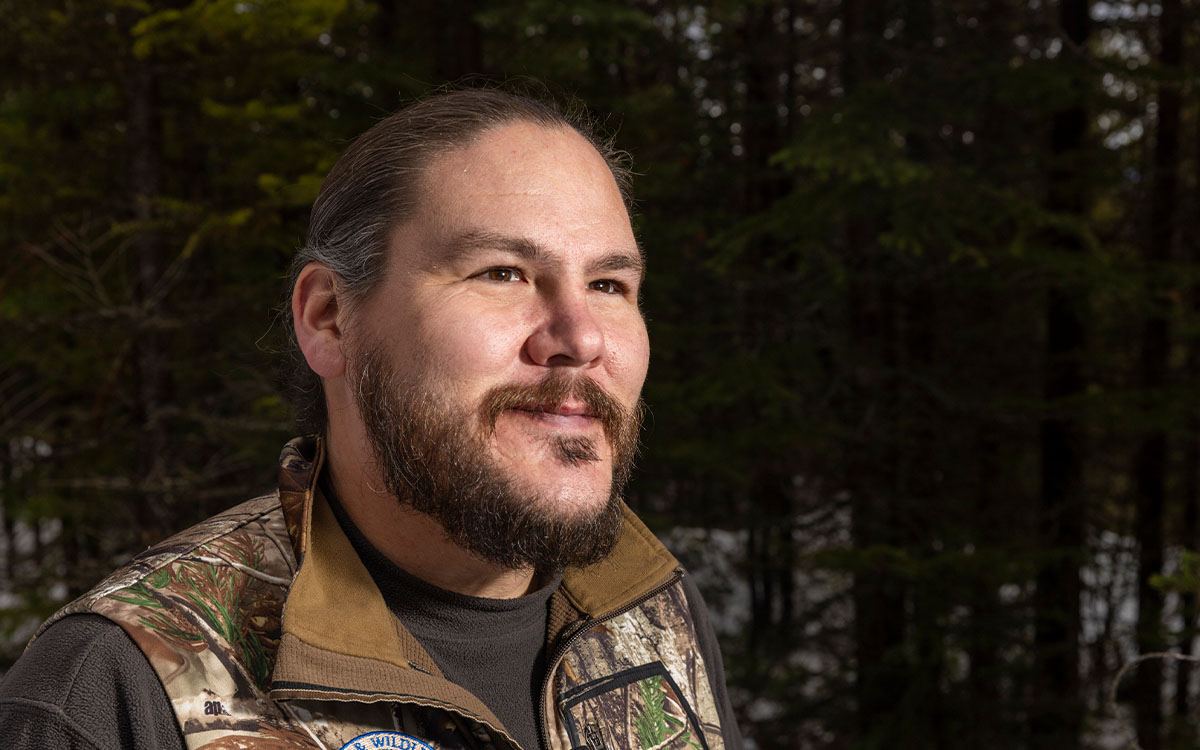
Wildlife manager Richard Whitney oversees all the Tribes’ projects to restore wildlife to their unceded lands.
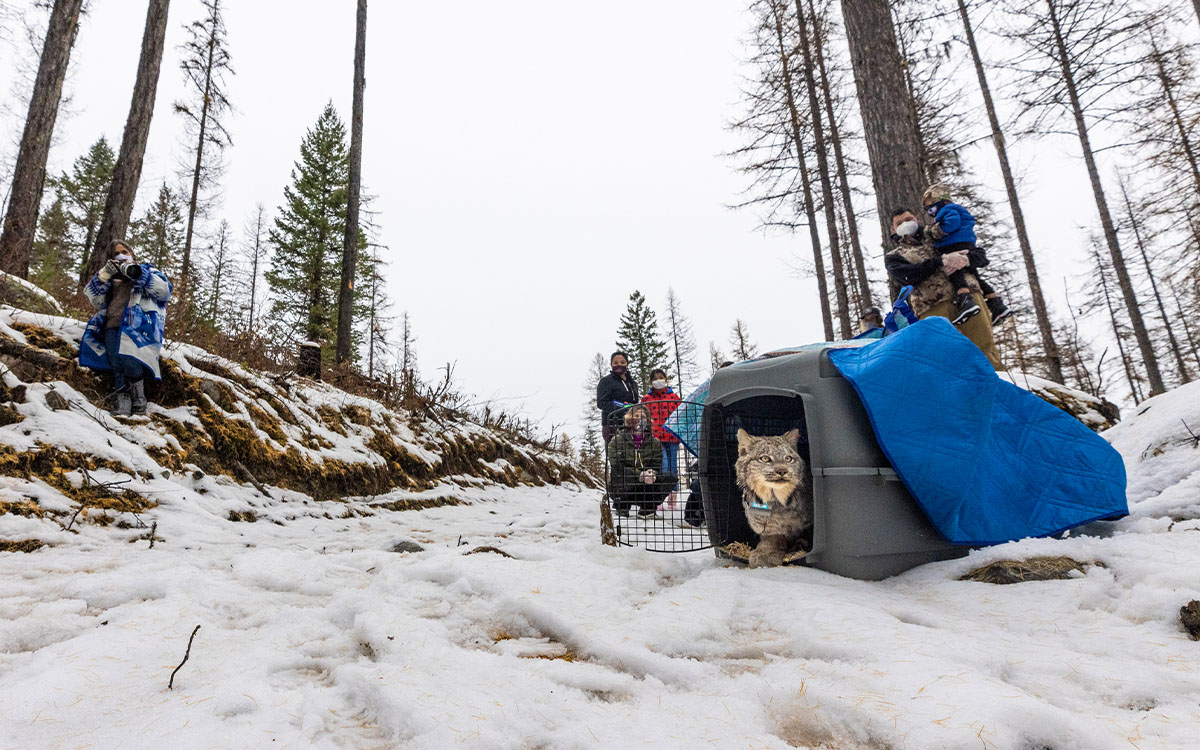
Tribal biologist Rose Piccinini releases a Canada lynx onto the reservation, while tribal members look on.
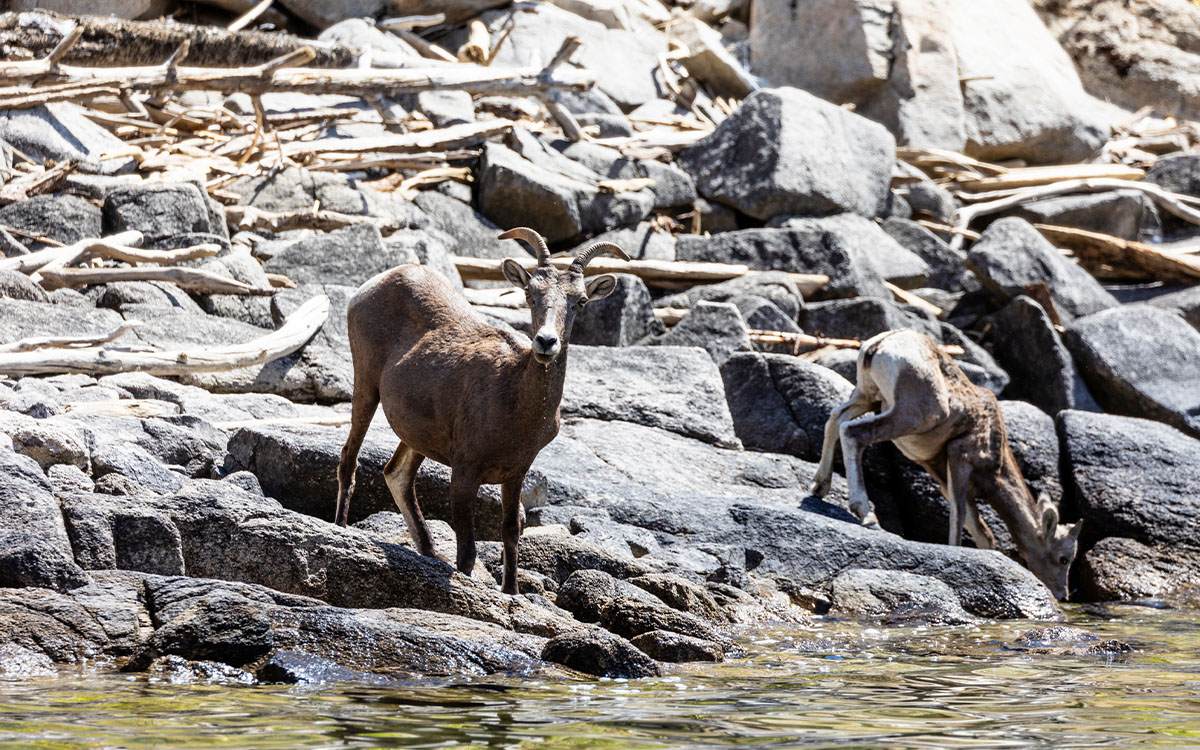
Bighorn sheep from the Hellgate herd along the Columbia River on the Colville Tribes’ reservation. These animals were restored to the reservation by the Tribes.
As Whitney assumed leadership of the wildlife division and took over the restoration of bighorn sheep, it was suggested to him that the Tribes sell licenses for trophy bighorn hunts to nontribal hunters to help pay for more staff. Some state fish and wildlife departments sell hunting licenses via auction or raffle for a number of species considered to be trophies to the highest bidder to generate revenue. For example, in Washington this year, one bighorn sheep hunting license generated $181,460, while a similar license was auctioned for $370,000 in Oregon.
Whitney was adamantly opposed to the idea, and his reasoning provides insight into the approach he takes to wildlife management: “That animal is worth more to me than a biologist position. That animal has value and it’s not in dollars,” he says. With so much wildlife management reliant on hunters paying license fees, which in turn fund conservation and management, Whitney says the priorities are off. “If it just comes down to money, then you guys are in the wrong business. You’ll never get it right.”
In addition to providing sustenance for tribal members, the restoration of native species serves to restore a community of species of which people are an integral part. “There’s a harmony there, and anything that’s missing breaks that balance,” Whitney says. “There’s still a harmony, but it’s missing a note here and there.” With each member of the ecological community Whitney’s wildlife department restores, the whole community sings fuller-voiced.
 The Magazine of The Sierra Club
The Magazine of The Sierra Club



